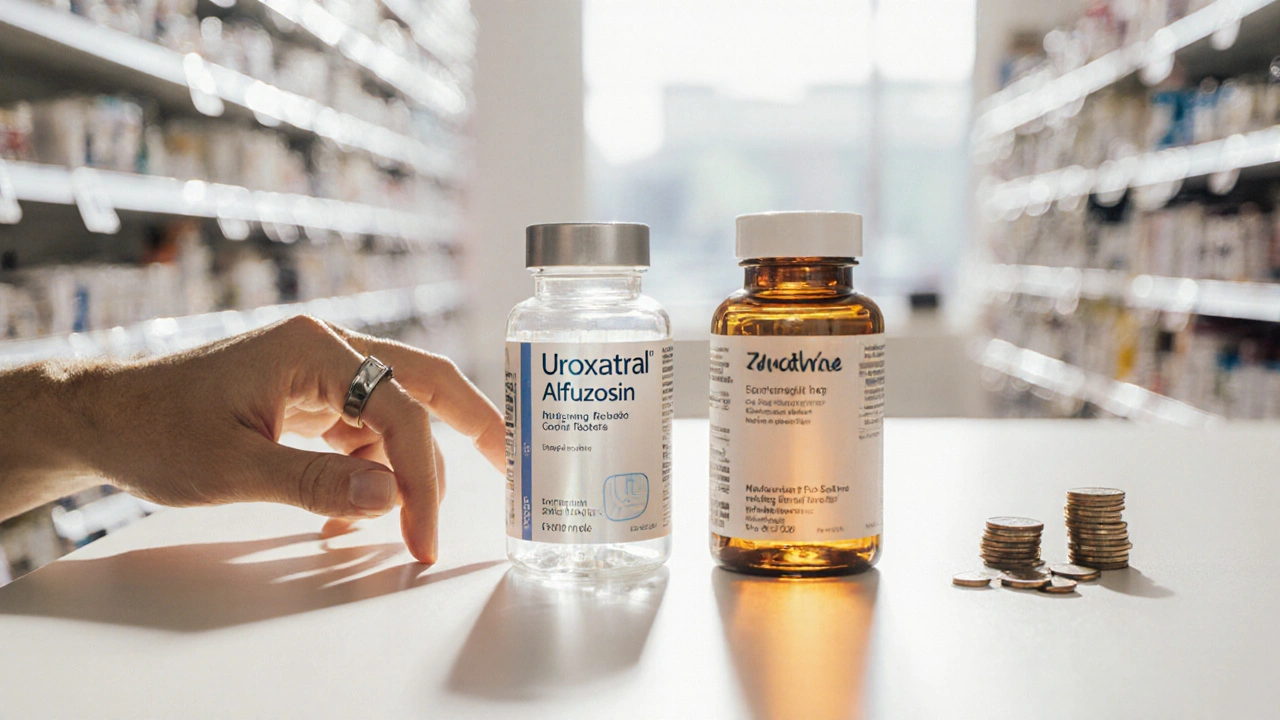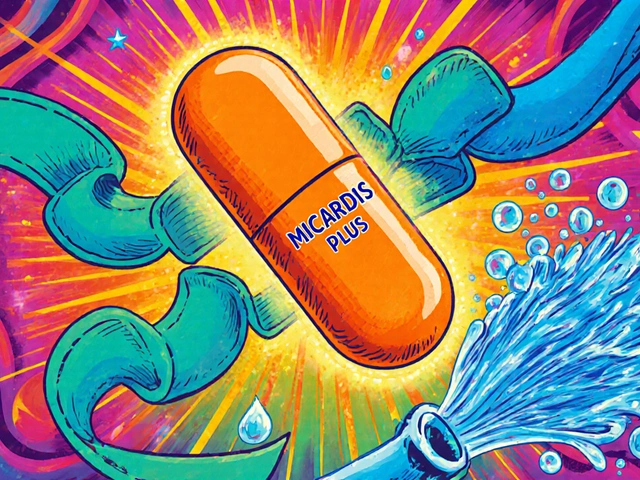BPH Treatment Comparison Tool
Select criteria to compare BPH medications:
Quick Takeaways
- Uroxatral (alfuzosin) is an alpha‑blocker that relaxes prostate muscle to ease urinary flow.
- It’s taken once daily after meals, with a low risk of dizziness compared with older alpha‑blockers.
- Typical alternatives include tamsulosin, doxazosin, silodosin, finasteride, and herbal saw palmetto.
- Choosing the right drug depends on side‑effect profile, cost, drug interactions, and whether you need prostate‑size reduction.
- Most men see symptom improvement within 2‑4 weeks, but full benefit may take up to 12 weeks.
Uroxatral (generic name alfuzosin) is an alpha‑adrenergic blocker approved for treating lower urinary tract symptoms (LUTS) caused by benign prostatic hyperplasia (BPH). It works by relaxing smooth muscle in the bladder neck and prostate, allowing urine to flow more freely.
How Uroxatral Works
Alfuzosin selectively blocks alpha‑1A receptors found predominantly in the prostate and bladder neck. By inhibiting these receptors, the drug reduces the muscle tone that squeezes the urethra. Unlike some older agents, alfuzosin has minimal effect on blood vessels, so it causes fewer episodes of orthostatic hypotension.
Key Attributes of Uroxatral
- Typical dose: 10mg tablet taken once daily after the first main meal.
- Onset of relief: 2‑4weeks for noticeable improvement.
- Metabolism: Primarily hepatic via CYP3A4; avoid strong inhibitors like ketoconazole.
- Half‑life: Approximately 8hours, but the once‑daily regimen maintains steady levels.
- Cost (UK, 2025): £12‑£15 per 30‑day supply on the NHS, with private price around £25.
- Common side effects: mild dizziness, headache, fatigue; serious cardiovascular events are rare.
What Are the Main Alternatives?
When doctors discuss “alternatives,” they usually mean other alpha‑blockers or drugs that shrink the prostate. Below are the most frequently prescribed options.
Tamsulosin (brand Flomax) - A highly selective alpha‑1A blocker taken once daily, often praised for its low blood‑pressure impact but known for “retrograde ejaculation.”
Doxazosin (brand Cardura) - A non‑selective alpha‑blocker taken once daily, effective for both BPH and hypertension, but carries a higher chance of dizziness.
Silodosin (brand Rapaflo) - Very selective for alpha‑1A receptors, reduces urinary symptoms quickly, yet often causes ejaculation issues.
Finasteride (brand Proscar) - A 5‑alpha‑reductase inhibitor that shrinks prostate size over months; best for larger glands but may lead to sexual side effects.
Saw palmetto - An herbal extract used by some men for mild symptoms; evidence is mixed, and it’s not regulated as a medication.

Side‑by‑Side Comparison Table
| Feature | Uroxatral (Alfuzosin) | Tamsulosin | Doxazosin | Silodosin | Finasteride | Saw Palmetto |
|---|---|---|---|---|---|---|
| Drug class | Alpha‑1 blocker (non‑selective) | Alpha‑1A selective | Alpha‑1 non‑selective | Alpha‑1A selective | 5‑α‑reductase inhibitor | Herbal supplement |
| Typical dose | 10mg once daily after meal | 0.4mg once daily after food | 4mg once daily | 8mg once daily | 5mg once daily | 320mg extract twice daily |
| Onset of relief | 2‑4weeks | 1‑2weeks | 2‑4weeks | 1‑2weeks | 3‑6months (size reduction) | Variable, often >8weeks |
| Major side effects | Dizziness, headache | Retrograde ejaculation, dizziness | Dizziness, orthostatic hypotension | Ejactulation issues, dizziness | Decreased libido, erectile dysfunction | Gastro‑intestinal upset, limited data |
| Interaction risk (CYP3A4) | High - avoid strong inhibitors | Low | Low | Low | Low | Negligible |
| Cost (UK, 2025) | £12‑£15 (NHS) / £25 private | £10‑£14 (NHS) / £22 private | £8‑£12 (NHS) / £20 private | £13‑£16 private only | £18‑£22 (NHS) / £30 private | £5‑£7 (OTC) |
| Best for | Men who want once‑daily dosing with minimal blood‑pressure drop. | Those who prioritize rapid symptom relief and can tolerate ejaculation changes. | Patients who also need hypertension control. | Quick relief and tolerable side‑effects if ejaculatory change is acceptable. | Large prostates (>30g) needing size reduction. | Mild symptoms, preference for natural approach. |
Decision‑Making Checklist
Use this quick list when you talk to your urologist or GP. Tick the items that matter most to you.
- Do you have high blood pressure? - If yes, consider doxazosin or a medication that also treats hypertension.
- Is retrograde ejaculation a deal‑breaker? - If so, avoid tamsulosin or silodosin.
- Are you on any strong CYP3A4 inhibitors (e.g., grapefruit, azole antifungals)? - If yes, Uroxatral may need dose adjustment.
- How large is your prostate (g)? - Larger than 30g often benefits from finasteride.
- What is your budget? - NHS coverage may favor alfuzosin or tamsulosin; private costs differ.
- Do you prefer a natural supplement? - Saw palmetto is an option, but discuss efficacy with your doctor.
Managing Common Side Effects
Regardless of the drug, a few strategies help keep you comfortable:
- Take the tablet with food (especially alfuzosin) to blunt dizziness.
- Stand up slowly from sitting or lying positions.
- Stay hydrated, but avoid excessive fluids before bedtime.
- If ejaculatory changes bother you, discuss dose timing or switching agents.
- Report any sudden drop in blood pressure, severe headaches, or persistent sexual dysfunction to your clinician.
When to Switch or Combine Therapies
Sometimes one drug isn’t enough. The guidelines suggest combined therapy (alpha‑blocker + 5‑α‑reductase inhibitor) for men with very large prostates and persistent symptoms after 6 months of monotherapy. For example, pairing Uroxatral with Finasteride can give fast symptom relief from the blocker and long‑term size reduction from the inhibitor.
Frequently Asked Questions
Can I take Uroxatral if I have low blood pressure?
Uroxatral is designed to have a lower impact on blood pressure than older alpha‑blockers, but it can still cause a mild drop. If your systolic pressure is consistently below 100mmHg, discuss dosage adjustments or an alternative with your doctor.
How long should I wait before seeing results?
Most men notice improved urine flow within 2weeks, but maximal benefit may take up to 12weeks. Keep a symptom diary to track changes.
Is it safe to combine Uroxatral with Finasteride?
Yes, the combination is common for men with larger prostates. The blocker works fast, while Finasteride shrinks the gland over months. Your doctor will monitor liver function and PSA levels.
What should I do if I experience dizziness after taking Uroxatral?
Take the tablet with a meal and avoid standing up quickly. If dizziness persists or you feel faint, contact your GP - a dose change or switch may be needed.
Are there any food or drug interactions I must avoid?
Alfuzosin is metabolised by CYP3A4, so avoid strong inhibitors like ketoconazole, erythromycin, and large amounts of grapefruit juice. Also, be cautious with other blood‑pressure medicines.
In short, Uroxatral offers a convenient once‑daily option with a modest side‑effect profile. If you need quicker relief, tighter blood‑pressure control, or a drug that also shrinks the prostate, the alternatives listed above may suit you better. Always have a frank conversation with your healthcare provider-personal health history, prostate size, and lifestyle all shape the final decision.





Dan Tourangeau
September 28, 2025 AT 05:07Alfuzosin’s once‑daily dosing and modest blood‑pressure effect make it a solid first‑line option for many men, especially when cost is a consideration on the NHS.
Bernard Valentinetti
September 29, 2025 AT 08:54Ah, the intricate ballet of alpha‑blockers-Uroxatral waltzes in with a gentle touch, while Tamsulosin pirouettes into the realm of ejaculatory intrigue; Doxazosin, however, drums a thunderous beat of hypotension-truly, a pharmacological symphony! 🎭💊
Kenneth Obukwelu
September 30, 2025 AT 12:40As noted, the cultural context of medication choice matters; different health‑care systems prioritize cost, speed of relief, or side‑effect profiles, and a thoughtful clinician will weigh those values when discussing Alfuzosin versus its peers.
Josephine hellen
October 1, 2025 AT 16:27When navigating the labyrinth of BPH therapy, one quickly discovers that the decision matrix extends far beyond mere efficacy numbers.
Patients, physicians, and health‑care systems each bring a distinct set of priorities that must be harmonized.
Cost, for instance, can be the decisive factor in a publicly funded setting like the NHS, where a £12‑£15 monthly price tag for Alfuzosin may tip the scales toward its adoption.
Conversely, a private payer might prioritize a medication with a faster onset of symptom relief, such as Tamsulosin, even if it carries a slightly higher price.
Side‑effect profiles, too, wield considerable influence; the modest dizziness associated with Alfuzosin may be tolerable for many, whereas the prospect of retrograde ejaculation can be a deal‑breaker for others.
Moreover, the presence of comorbid hypertension steers clinicians toward agents like Doxazosin that address both urinary and blood‑pressure concerns.
The pharmacokinetic nuances, such as Alfuzosin’s reliance on CYP3A4 metabolism, introduce another layer of complexity for patients on interacting drugs.
Patients who are already on strong CYP3A4 inhibitors must either adjust their regimen or consider an alternative with a lower interaction risk.
From a mechanistic standpoint, the distinction between alpha‑blockers and 5‑alpha‑reductase inhibitors like Finasteride is pivotal, especially for men with larger prostates.
Finasteride’s gradual prostate‑size reduction offers a long‑term solution but demands patience, often taking six months or more to manifest.
In contrast, Alfuzosin delivers symptomatic relief within weeks, providing immediate quality‑of‑life benefits.
Lifestyle considerations, such as the timing of medication relative to meals, also play a practical role; taking Alfuzosin with food can mitigate dizziness.
Finally, patient preference-whether for a once‑daily pill, a desire to avoid sexual side effects, or a penchant for natural supplements like Saw Palmetto-must be given weight in shared decision‑making.
The art of medicine lies in weaving these threads into a personalized tapestry that respects both clinical evidence and individual values.
Open communication with the urologist, regular symptom tracking, and willingness to adjust therapy are the hallmarks of successful management.
In summary, Alfuzosin stands as a versatile, well‑tolerated option, but the optimal choice ultimately hinges on a nuanced appraisal of each patient’s unique context.
Ria M
October 2, 2025 AT 20:14Alfuzosin whispers calm where other blockers roar chaos.
Michelle Tran
October 4, 2025 AT 00:00Meh, the side‑effects list is fine 😑.
Caleb Ferguson
October 5, 2025 AT 03:47For patients concerned about blood‑pressure drops, Alfuzosin’s lower orthostatic impact makes it a safe choice; its once‑daily schedule also improves adherence compared with multiple‑dose regimens.
Clinicians should still monitor for dizziness and counsel patients on rising slowly from seated positions.
Delilah Jones
October 6, 2025 AT 07:34If you need rapid relief, Tamsulosin outpaces Alfuzosin in onset.
Pastor Ken Kook
October 7, 2025 AT 11:20Got to love how the table makes comparison a breeze :)
Just remember to factor in personal health goals.
Jennifer Harris
October 8, 2025 AT 15:07Balancing efficacy, side‑effects, and cost is a nuanced process that benefits from clear communication between patient and provider, ensuring the chosen therapy aligns with both clinical evidence and individual lifestyle.